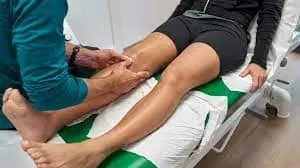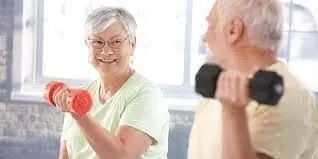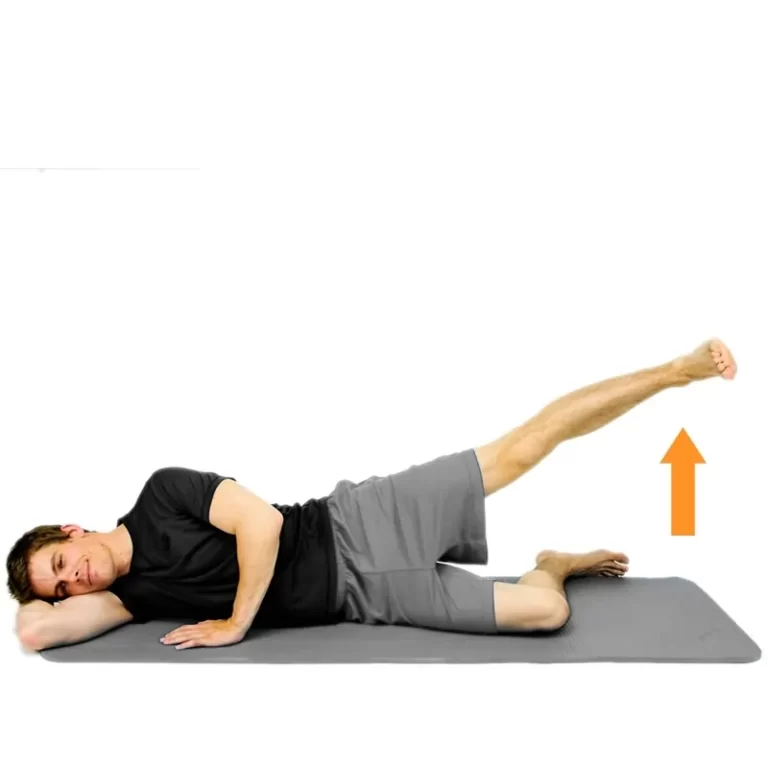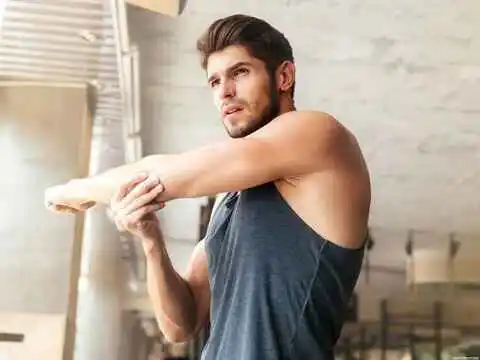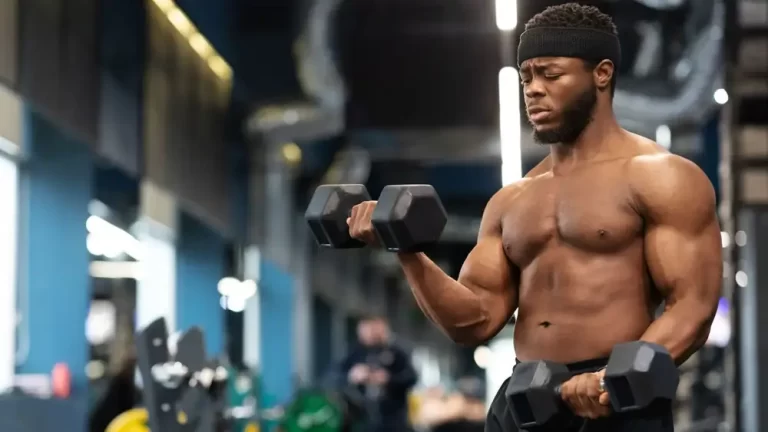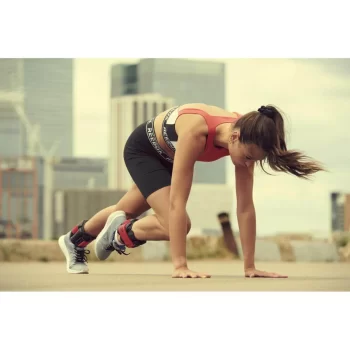15 Best Exercises For Deep Infrapatellar Bursitis
The disease known as deep infrapatellar bursitis is characterized by inflammation of the bursa right below the kneecap, under the patellar tendon.
Exercises for deep infrapatellar bursitis help reduce stress in the affected area and promote strength, flexibility, and pain alleviation to manage the symptoms of this condition effectively. With a concentration on improving knee function and minimizing pain, we will examine some of the finest Exercises For Deep Infrapatellar bursitis in this introduction.
Introduction:
The tiny sacs or pockets called bursae are found between tendons, muscles, and bones. They offer lubrication and cushioning, This permits the soft tissues to freely move over the bone or against one another. The bursae surrounding the knee come in several varieties. The patellar tendon, a large tendon that joins the quadriceps to the leg, is surrounded by the deep infrapatellar bursa, which is situated beneath the patella.
The Superficial Infrapatellar Bursa is located between the patellar tendon and the skin covering it on the tendon’s anterior side.
Under the patellar tendon, between the tendon and the tibia (shin), is the Deep Infrapatellar Bursa. The deep and superficial bursa within the patella is seen as one continuous body.
Causes:
If you don’t exercise or stay active, your muscles may weaken and your knee may lose the support it needs to function properly.
Overuse, damage, or breakdown of the knee’s protective tissue are the usual causes of inflammation of the infrapatellar bursae or the surrounding tendons.
Particular reasons consist of;
- Infection (septal bursitis)
The closer the bursa is to the skin’s surface, the higher the chance that it will become infected with certain bacteria that are frequently found there. The common bacteria that causes this infection is called Staphylococcus Epidermis (or Staphylococcus aureus).
- Acute injury
In sports, a direct hit to the upper part of the tibial knee might result in a fall on the knee or damage to the infrapatellar bursa. In these situations, there is a chance that blood could leak into the bursa, resulting in pain, inflammation, and irritation.
- Persistent crawling or kneeling
Standing on one knee compresses the knee due to increased pressure going through it. Bursa swelling and thickening result from this.
- Overstress
Your knee may lose the muscle support it needs to move properly if you don’t exercise or engage in other physical activity. Your weight may be distributed unevenly within your knee joint as a result, or your knees and hips may bear an excessive amount of stress. When weight is distributed unevenly, some regions may experience greater stress than others, which will cause abnormal wear and tear on the stressed areas.
Signs and symptoms:
- Knee pain
Usually causing pain below the knee, deep infrapatellar bursitis is felt in the front of the knee, directly below the patella. The leg’s anterior surface is affected by the pain. Pain from deep Infrapatellar bursitis is typically worsened by knee bending and stairs. Because the knee compresses the bursa, it hurts a lot.
- Fever
Fever as a sign of deep infrapatellar bursitis. The presence of organisms in the knee joint causes fever and an elevated white blood cell count in patients with septic infrapatellar bursitis.
- Intense redness and warmth
Bursitis patients may have redness on the front of their knees and feel warm when they touch.
- Inability to sleep
Bursitis frequently interferes with sleep and causes sensations of pain when one bends the knee or falls asleep, which frequently wakes the patient.
- Swelling in the knee area
Infrapatellar bursitis frequently causes swelling around the front of the knee. Immediately below the kneecap, at the front of the lower leg, there may be an extensible pocket of fluid that is tender to the touch.
- Weakened and stiff knees
Joint stiffness and weakening can eventually result from restricted knee use caused by knee discomfort.
Risk factors:
Some factors that are thought to increase the likelihood of developing deep infrapatellar bursitis include the following;
- Engaging in sports involving contact
Sports like basketball, rugby, football, and wrestling all need powerful knees, which increases the risk of prepatellar bursitis.
- Immunodepressive state
Diabetes and other immune-system-compromising conditions make you more open to infections that can lead to deep patellofemoral bursitis.
- Either gout or rheumatoid arthritis
You have an increased risk of developing deep patellofemoral bursitis if you have gout or rheumatoid arthritis.
- Kneeling repeatedly
Kneeling involves applying stress to the knee and the prepatellar bursa. The ailment known as deep patellofemoral bursitis is more prevalent in people who frequently kneel, particularly when working.
Think about the following safety measures before beginning an exercise plan:
Every exercise protocol should start with a few safety precautions to maximize the advantages. Consult a physician or physical therapist to determine the right exercises for your specific problem. You must listen to your body and stop pushing yourself when it becomes painful. While soreness following exercise is normal, severe or chronic pain could indicate excessive training.
Maintaining proper form and technique is essential to avoiding repetitive injury. See a doctor if you’re unsure how to follow an exercise program correctly. Warming up your muscles and joints before an exercise session is useful.
Exercises For Deep Infrapatellar Bursitis:
The right stretches and activities must be chosen when developing an exercise routine to help heal knee bursitis. To recover knee function and resume a regular life, consider some of the suggestions below.
Side-lying leg raise
- Either the floor or a yoga mat can be used to sleep on your right side.
- By keeping your feet flat on the ground and your legs up, you may maintain an upright posture.
- As an alternative, support yourself by holding your arm with your elbow bent or by placing it straight on the ground beneath your head.
- For further support, place your left hand on your hip or leg or hold it out in front of you.
- Raise your left leg off the ground.
- Stop elevating your leg as soon as you feel the muscles contract.
- After inhaling deeply a few times, pull the leg down until it contacts the right leg again.
- Then return to your neutral position.
- Then relax.
- Repeat this exercise five to ten times.
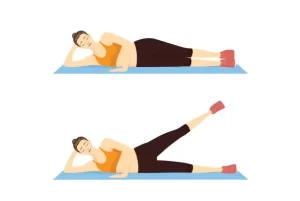
Calf stretch
Increased flexibility and less knee pain can be achieved by stretching your calves.
- Lean up against a wall.
- Make sure to keep your posture straight during the exercise.
- Place the leg that has to be stretched behind you and take a stride forward.
- Proceed forward until you feel pressure in your knee or calf while maintaining a straight knee on the leg you are extending.
- Hold this position for a few seconds.
- Then return to your neutral position.
- Then relax.
- Repeat this exercise five to ten times.
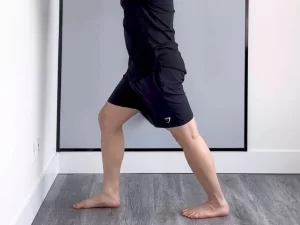
Standing quadriceps stretching
- For stability, place yourself against a wall.
- The distance between your feet must be shoulder-width.
- Push your foot into your glutes by bending one knee.
- While holding your ankle, gently bring it in the direction of your glutes.
- Hold this position for a few seconds.
- Put your leg down.
- Then return to your neutral position.
- Then relax.
- Repeat this exercise five to ten times.
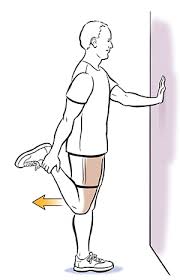
Heel slide
- When you sleep on your back, keep your legs straight.
- Bend the knee and gently slide one heel back toward the buttock.
- Keep your posture like this for a short while.
- Slowly extend your heel in the other direction after your leg is straight.
- Then return to your neutral position.
- Then relax.
- Repeat this exercise five to ten times.
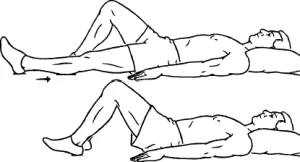
Straight leg raise
- Start by finding a comfortable spot to lie on the floor or a table.
- Next slightly bend your knees.
- After that, raise one leg slowly.
- However, keeping the other knee straight.
- Hold this position for a few seconds.
- After that, lower your leg.
- Then return to your neutral position.
- Then relax.
- Repeat this exercise five to ten times.
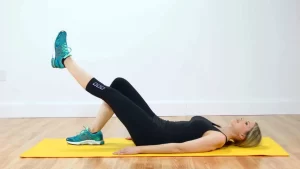
Hamstring stretch
- Start on the ground in a comfortable laying position.
- Just one knee should be bent at this point.
- Position your hands slightly behind your knees.
- Raise one leg to your chest and raise it off the ground.
- You can loop the band over your thigh if you have trouble getting your hands behind your leg.
- Grasping it with your band, bring your leg closer to you.
- Hold this position for a few seconds.
- Next, let go of your leg.
- Then return to your neutral position.
- Then relax.
- Repeat this exercise five to ten times.
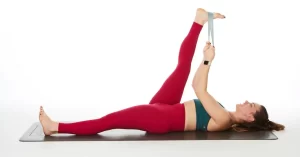
Single leg balance
- Get into an upright posture.
- Keep your arms at your sides.
- Raise one foot behind you by bending it at the knee.
- Take a stand and use your other foot to balance.
- Hold this position for a few seconds.
- Bring the elevated foot down.
- Then return to your neutral position.
- Then relax.
- Repeat this exercise five to ten times.
- Repeat on the other side.
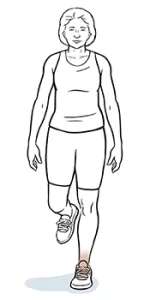
Static quadriceps exercise
- Stretch your legs straight out in front of you while sitting or lying down with your back supported.
- Under your knee, put a rolled-up towel.
- One foot should be pushed toward you with a slight sideways angle.
- Firmly pressing your knee down should cause your thigh muscles to tense.
- Hold this position for a few seconds.
- Then return to your neutral position.
- Then relax.
- Repeat this exercise five to ten times.
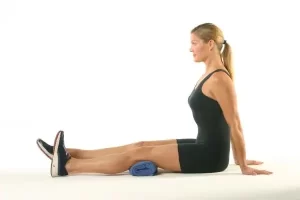
Prone leg raise
- Instead of working out on a hard floor, you can use a mat or a plinth to give yourself some support.
- You can first extend your legs behind you while lying on your stomach.
- If this seems uncomfortable, you are free to put your head between your arms.
- Using your left leg, extend your leg as far as it will go without hurting by contracting your hamstring and gluteus muscles.
- A pelvic bone stabilization by the physical therapist is required before beginning this activity.
- Hold this position for a few seconds.
- Then return to your neutral position.
- Then relax.
- Repeat this exercise five to ten times.

Step up
- Take a comfortable standing position to start.
- Put one at the foot of a step bench, the lowest step of a stairwell, or a platform.
- Maintain your height at your pelvic level.
- Slowly lower your opposing foot to the ground while bending your knee.
- After placing your toe lightly on the ground, step back up to take your spot.
- Then return to your neutral position.
- Then relax.
- Repeat this exercise five to ten times.
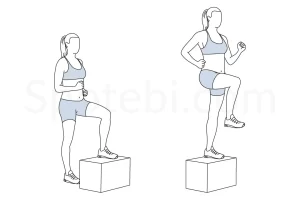
Seated knee extension
- Sit upright in a long chair, placing your leg on the floor or a plinth.
- To increase your strength without getting out of the chair, tense your thigh muscles, face forward, and raise one leg as high as you can.
- Hold this position for a few seconds.
- Lower your leg then.
- Then return to your neutral position.
- Then relax.
- Repeat this exercise five to ten times.
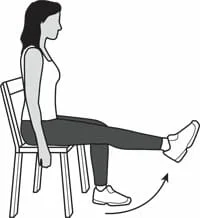
Butterfly stretch
- The initial position is seated.
- Keep your head and body up when you’re sitting on the ground.
- Your legs are formed by forming a triangle with the soles of your feet.
- For the benefit of the patient, as much as possible, bend the knees to the sides.
- Patients may also apply pressure with their arms on their knees for a deeper stretch.
- Maintaining the body as well as the head of the patient as straight as possible.
- Patients’ inner thighs are being stretched.
- Hold this position for a few seconds.
- Then return to your neutral position.
- Then relax.
- Repeat this exercise five to ten times.
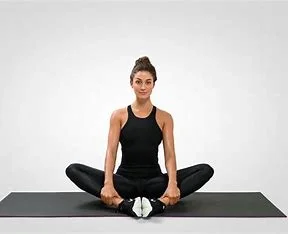
Wall sit
- When you are facing a wall, your feet should be about two feet from the wall and shoulder-width apart.
- Squeeze your abs and carefully drop your back down the wall after your thighs are level with the floor.
- Instead of placing your feet over your toes, position them such that your knees are squarely above your ankles.
- Stay facing the wall with your back flat.
- Hold this position for a few seconds.
- After standing up straight, turn around and proceed back up the wall.
- Then return to your neutral position.
- Then relax.
- Repeat this exercise five to ten times.
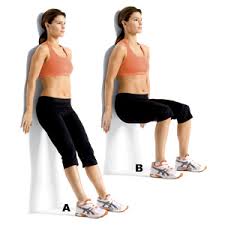
Lateral band walking
- After wrapping the band around both legs, somewhat above each knee, it should be flat and not twisted.
- Maintain a shoulder-width distance between your feet.
- While not excessively stretched, the band should be tight.
- Bending your knees slightly and taking a half-squat will cause your gluteus medius to contract.
- As you face forward, keep both of your feet parallel to your shoulders and your body weight properly distributed.
- Move your weight over one leg and your other leg sideways while maintaining your half-squat position.
- This leg should be moved sideways in and out five to ten times.
- Hold your hips level throughout the workout.
- When doing this exercise, it helps to keep your posture low and forward-facing.
- Modify your weight and your legs progressively.
- Then return to your neutral position.
- Then relax.
- Repeat this exercise five to ten times.
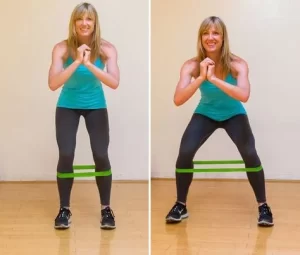
Prone knee bends
- Laying prone on the bed or table, find an ideal position for yourself.
- At this point, gradually bend your knee to a comfortable posture.
- Hold this position for a few seconds.
- Release your leg.
- Then return to your neutral position.
- Then relax.
- Repeat this exercise five to ten times.
- Continue to the opposite side.
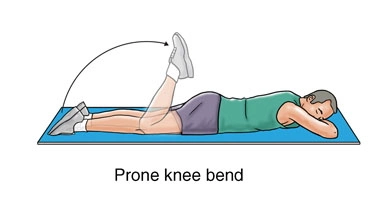
What safety precautions are required when exercising?
- When exercising, try to avoid making any rapid or forceful movements.
- Stay away from challenging activities.
- Stretch and bend moderately.
- While working out, maintain a straight posture.
- Make sure you are properly fit for the equipment you utilize.
- Take care of yourself and stay alert to avoid falling as you exercise.
- Dress comfortably and loosely to maximize your range of motion and promote relaxation during your workout. Avoid wearing clothing that is very tight or overly stylish.
- In between exercise sessions, take a rest.
- It’s common if sometimes challenging, to stretch your stiff joint muscles. Exercise and stretches shouldn’t cause you pain or give you the feeling that someone is stabbing you because they are unhealthy and make your illness worse.
- As soon as the pain becomes intense, quit exercise.
- Holding your breath while exercising is never recommended. When you exercise, you should take deep breaths and release them slowly. Inhaling deeply causes your muscles to tense up and your blood pressure to rise.
- Stretches should be performed according to the protocol before and after sets and for the suggested amount of repetitions for every exercise.
- Stay hydrated.
When will you stop exercising?
- Fever
- Headache
- If exercising hurts, you should stop.
- Intense muscle burning.
- You’re not feeling well.
- If there is pain or numbness.
Prevention:
- Both before and after exercise, stretch
Stretching activities can help prevent bursitis. Before starting the activity, warm up with some mild stretching. It releases tension from the legs’ joints and muscles. It’s important to stretch a little to aid in your recovery from your workout. This reduces the possibility of discomfort and inflammation surrounding the knee joint. For warming up and cooling down, static stretches are a great choice.
- Stay away from high-impact activity
Avoiding strenuous activity is advised if you are prone to knee bursitis. This covers activities like sports, running, and jumping. Stretch properly before and after this exercise, and take regular pauses. For those who have knee bursitis, low-impact exercise is preferable. These consist of cycling, swimming, and walking. To increase your likelihood of maintaining an activity, try to choose something you enjoy.
- Utilize a support such as a knee pad
When engaging in an activity that may result in knee bursitis, it is a good idea to utilize some sort of support. Anything from knees to braces or a wrap can be used for this. This will help to support your knees and lower your chance of bursitis. You can experiment with several types of support. For sports like skateboarding or cycling, knee protectors are a wise investment. If you participate in sports, a brace or wrap can help in joint stabilization and help stop more damage. Be sure to discuss whatever kind of support is right for you with your doctor.
- Put on supportive, well-fitting footwear with plenty of cushioning
To choose the best shoes for knee bursitis, choose supportive, well-fitting styles. Comfortable clothing is also essential for reducing joint tension. A variety of shoe styles can be helpful in the management of knee bursitis. Cross-trainers and running shoes are typically excellent options because they provide significant cushioning and support.
- Allow yourself enough time to relax and heal
You must take a break from your regular activities if you experience pain and swelling in the area surrounding your knee. Muscle relaxation results from rest. Ice the region for twenty minutes many times a day, if necessary. To lessen pain and inflammation, you can also use over-the-counter medications like acetaminophen or ibuprofen. It is worthwhile to visit a doctor if the pain is severe or persists for longer than seven days. They may advise different treatment plans or stronger medications.
FAQ:
Regarding knee bursitis, is exercise beneficial?
For the treatment of knee bursitis, begin with slow stretching and progress to strengthening exercises. Exercises like heels, straight leg raises, and quads are beneficial if you have knee bursitis.
What is the treatment for deep infrapatellar bursitis?
Avoiding actions that put a strain on the infrapatellar bursa and related tendons (such as jumping, jogging, and kneeling) is part of the initial treatment for deep infrapatellar bursitis. using ice to pain and inflammation. Serum outflow into the deep infrapatellar bursa under extreme situations.
Can infrapatellar bursitis be helped by physical therapy?
The following are typical physical therapy interventions used to treat infrapatellar bursitis: The Manual Therapeutic Technique (MTT) is a hands-on approach used by physical therapists to help patients regain knee range of motion and mobility.
I have bursitis; is it okay to exercise?
While some types of stretching can be highly beneficial, others can worsen knee bursitis. The most important piece of advice to live by is “Always listen to the body.” Stop engaging in any activity even a seemingly ordinary stretch if it makes the joint pain worse.
What is the duration of recovery for infrapatellar bursitis?
The swelling and other symptoms normally go away in a few weeks if you rest and take home remedies for your prepatellar bursitis. Consult your healthcare physician if, despite two or three weeks of rest, your prepatellar bursitis doesn’t improve. You may require medical attention.
Can someone with knee bursitis walk?
Walking may make knee bursitis symptoms worse, so it’s critical to pay attention to your body’s signals and take it easy if you’re in pain. However, walking helps reduce swelling and is unlikely to do more harm to the joints.
To what extent is infrapatellar bursitis painful?
Particularly when the knee is bent, this condition is very uncomfortable. It can therefore be very painful to walk and climb stairs. However, while the person is at rest or not moving, they only experience a little pain.
References:
- As of September 17, 2023, Prajapati, D. The Top 13 Activities for Deep Infrapatellar Bursitis – Samarpan. Samarpan Physical Therapy Clinic. The ideal exercises for deep infrapatellar bursitis can be found at https://samarpanphysioclinic.com/
- MendMeShop. [n.d.]. bursitis infrapatellar. Inflammrapatellar bursitis causing knee pain: https://mendmyknee.com/knee-and-patella-injuries.php
- On September 4, 2020, Dpt, J. V. P. Home Exercises for Knee Bursitis. Feel Well Vive. exercises for knee bursitis https://www.vivehealth.com/blogs/resources/knee-bursitis-exercises?srsltid=AfmBOop9_AVGTZba3x22xhijSDskoqxGG0hxEiyKvHsSsREOdt2T7vOt
- Clinic for ProHealth Prolotherapy. July 6, 2024. The causes and best treatment options for infrapatellar bursitis in 2024. Infrapatellar bursitis: https://prohealthclinic.co.uk/blog/

